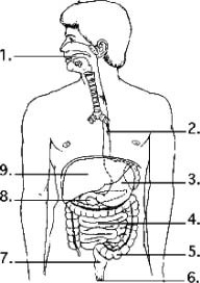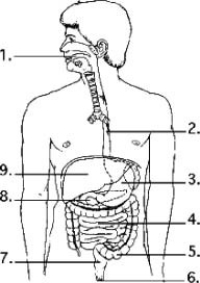A) a decreased ability to produce thyroid hormones
B) a decrease in enzyme function
C) the animal to have weak bones
D) a decrease in muscle function
Correct Answer

verified
Correct Answer
verified
Multiple Choice
An advantage of a complete digestive system over a gastrovascular cavity is that the complete system ________.
A) excludes the need for extracellular digestion
B) allows for specialized regions with specialized functions
C) allows extensive branching
D) facilitates intracellular digestion
Correct Answer

verified
Correct Answer
verified
Multiple Choice
Pepsinogen is converted to its active form in the stomach by ________.
A) HCl
B) chief cells
C) high pH conditions
D) parietal cells
Correct Answer

verified
Correct Answer
verified
Multiple Choice
Why do the cells of the digestive system secrete proteolytic enzymes, such as pepsin, in their inactive forms?
A) These proteolytic enzymes, in active form, would digest the very tissues that synthesize them.
B) By secreting inactive enzymes, the catalytic activity of the enzymes is maintained for a longer time.
C) The stomach is too acidic to maintain these enzymes in their active form.
D) Inactive pepsin and trypsin are more easily transported across the cell membrane
Correct Answer

verified
Correct Answer
verified
Multiple Choice
In the digestive system, peristalsis is ________.
A) a process of fat emulsification in the small intestine
B) voluntary control of the rectal sphincters regulating defecation
C) the transport of nutrients to the liver through the hepatic portal vessel
D) smooth muscle contractions that move food along the esophagus
Correct Answer

verified
Correct Answer
verified
Multiple Choice
A significant contribution of intestinal bacteria to human nutrition is the benefit of bacterial ________.
A) production of vitamins A and C
B) absorption of organic materials
C) production of vitamin K
D) recovery of water from fecal matter
Correct Answer

verified
Correct Answer
verified
Multiple Choice
Which of the following is a difference between vitamins and minerals?
A) Vitamins are involved in regulating enzyme activity, but minerals are not.
B) Vitamins are organic molecules, but minerals are inorganic molecules.
C) Minerals are obtained by an animal through dietary sources, but vitamins are made by the animal.
D) Vitamins and minerals are only obtained by digesting plants.
Correct Answer

verified
B
Correct Answer
verified
Multiple Choice
Ticks are parasites that obtain nutrients by ingesting blood from a host animal. Ticks would be classified as ________.
A) filter feeders
B) substrate feeders
C) fluid feeders
D) bulk feeders
Correct Answer

verified
Correct Answer
verified
Multiple Choice
A zoologist analyzes the jawbones of an extinct mammal and concludes that it was an herbivore. The zoologist most likely came to this conclusion based upon the ________.
A) position of muscle attachment sites
B) shape of the teeth
C) size of the mouth opening
D) angle of the teeth in the mouth
Correct Answer

verified
Correct Answer
verified
Multiple Choice
If you place a small piece of a cracker on your tongue, what would you expect to happen?
A) The vitamins in the cracker are immediately absorbed.
B) Salivary amylase degrades the starch from the cracker into glucose.
C) The proteins in the cracker begin to be digested.
D) The flavor becomes less noticeable because the sugars are digested.
Correct Answer

verified
Correct Answer
verified
Multiple Choice
The large surface area in the gut directly facilitates ________.
A) secretion
B) absorption
C) filtration
D) temperature regulation
Correct Answer

verified
Correct Answer
verified
Multiple Choice
Which of the following organs is correctly paired with its function?
A) stomach-fat digestion
B) large intestine-bile production
C) small intestine-polysaccharide digestion
D) pancreas-starch digestion
Correct Answer

verified
Correct Answer
verified
Multiple Choice
What benefit is gained by intestinal bacteria living in a mutualistic relationship with an animal?
A) The bacteria are provided with a regular source of nutrients.
B) Temperature is always regulated.
C) The bacteria can easily infect the animal's intestinal cells.
D) The bacteria can avoid the animal's immune system.
Correct Answer

verified
Correct Answer
verified
Multiple Choice
 Examine the digestive system structures in the figure. Most of the digestion of fats occurs in structure(s) ________.
Examine the digestive system structures in the figure. Most of the digestion of fats occurs in structure(s) ________.
A) 3 only
B) 4 only
C) 1 and 4
D) 3 and 4
Correct Answer

verified
B
Correct Answer
verified
Multiple Choice
 Examine the digestive system structures in the figure. Bacteria that produce vitamins are found in the greatest concentration in location ________.
Examine the digestive system structures in the figure. Bacteria that produce vitamins are found in the greatest concentration in location ________.
A) 3
B) 4
C) 5
D) 8
Correct Answer

verified
Correct Answer
verified
Multiple Choice
Upon activation by stomach acidity, the secretions of the parietal cells ________.
A) initiate the chemical digestion of protein in the stomach
B) initiate the mechanical digestion of lipids in the stomach
C) initiate the chemical digestion of lipids in the stomach
D) delay digestion until the food arrives in the small intestine
Correct Answer

verified
Correct Answer
verified
Multiple Choice
A relatively long cecum is characteristic of animals that are ________.
A) carnivores
B) herbivores
C) autotrophs
D) omnivores
Correct Answer

verified
Correct Answer
verified
Multiple Choice
After surgical removal of the gallbladder, a person might need to limit his or her dietary intake of
A) starch.
B) protein.
C) sugar.
D) fat.
Correct Answer

verified
D
Correct Answer
verified
Multiple Choice
The process by which digested dietary substances cross cell membranes to be used by the body is known as ________.
A) ingestion
B) digestion
C) hydrolysis
D) absorption
Correct Answer

verified
Correct Answer
verified
Multiple Choice
When used appropriately, antibiotic treatment can effectively reduce bacteria populations and help fight infections. However, antibiotic treatments can have unintended effects. What is one concern when using antibiotics?
A) Antibiotics also damage animal cells, so they can be more harmful than a bacterial infection.
B) Antibiotics cause viruses to become more effective at infecting cells.
C) Each antibiotic is only effective against one type of bacteria, so effects on infection are limited.
D) Antibiotics may also kill the beneficial bacteria of the microbiome, thereby disrupting digestive health.
Correct Answer

verified
Correct Answer
verified
Showing 1 - 20 of 64
Related Exams